Markets
Here’s how MiCA regulation will impact the European cryptocurrency market

The following is a guest post by Mike Romanenko, CVO and co-founder of Kyrrex.
The European crypto landscape is set to undergo a major transformation with the introduction of the Markets in Crypto Assets (MiCA) regulation. Mike Romanenko, CVO and co-founder of Kyrrex, predicts that this regulation will present multiple opportunities and challenges for crypto players in European countries.
Expected changes after MiCA adoption
THE Adoption of MiCA The entry into force of the new regulations in European countries marks a radical change for the cryptocurrency industry. For market participants, these regulations introduce strict rules governing various facets of the industry, including cryptocurrency exchanges, custody of funds, and customer verification processes. While these rules may seem quite restrictive at first, they are designed to improve the security and transparency of cryptocurrency operations.
Most importantly, one of MiCA’s primary goals is to protect end users by ensuring that companies adhere to transparent auditing practices and maintain verifiable reserves. This need for transparency has become particularly evident after the many bankruptcies of large crypto companies since 2020, including FTX Crashwhich exposed vulnerabilities and risks within the sector.
I believe that regulation will facilitate the entry of institutional investors into the cryptocurrency market. By establishing clear and consistent rules, MiCA can help attract significant institutional and corporate funds, thereby strengthening the liquidity and stability of the market. The situation reflects the introduction of Bitcoin ETF in the United States, which allowed institutional investors to gain exposure to Bitcoin through regulated financial products.
The challenge of implementation
Despite the long-term benefits, I didn’t expect the initial phase of MiCA implementation to be easy. Europe currently has around 2,000 virtual asset service providers (VASPs), many of which are in no rush to comply with the upcoming regulations. Local authorities will face considerable pressure to review and approve applications quickly, which could lead to potential backlogs and operational delays.
Some countries, such as Malta and France, have already started to align their regulations with MiCA, but the overall level of preparedness varies considerably across Europe. I expect this disparity to lead to a period of confusion and disruption as businesses work to comply with the new standards.
The entire process is planned to last three years, from June 2023 to July 2026, and includes the following steps:
- Entry into force of MiCA (June 2023).
- Deadline to waive the grandfather clause or reduce the duration (June 2024).
- Entry into force of MiCA (December 2024).
- End of the transitional phase (July 2026).
MiCA has the potential to have a significant impact on the cryptocurrency market within the EU. I would like to highlight the following expected effects:
- Enhanced consumer protection. The aim of MiCA is to establish clear rules for crypto-assets, providing better protection for investors.
- Greater market integrity. By establishing governance standards, MiCA aims to promote fair competition and prevent market abuse.
- Simplified cross-border operations. A harmonised regulatory ecosystem will make it easier for EU businesses to operate across borders.
- Stimulating innovations. The pilot scheme for distributed ledger technology (DLT) market infrastructures could lead to more efficient blockchain-based financial systems.
I would say that the key aspect of MiCA is the new classification of crypto-assets, known as CASP: crypto-asset service providers. It includes exchanges, custodian wallet providers and trading platforms, which will be subject to authorisation by national authorities. The classification aims to ensure that all entities providing crypto services comply with the same regulations.
Regulatory Challenges and Opportunities in the United States and Other Countries
Unlike Europe, the United States does not have a unified regulatory framework for cryptoassets, leading to significant uncertainty. While Bitcoin is classified as a commodity, the status of other digital assets, such as Ethereum, remains ambiguous. Despite what I wanted to see, this lack of clarity complicates compliance and increases the risk of regulatory action against crypto businesses.
There are, however, many positive developments. The introduction of money transmitter licenses (MTLs) for cryptocurrency exchanges has allowed companies to operate legally in several states. Full federal regulation is still pending and is unlikely to be addressed before the next election.
Hopefully, the implementation of MiCA in Europe can serve as a valuable model for other regions, including the US, UK, Turkey, and India. I would like to see that in countries like India, where cryptocurrencies are currently banned, a MiCA-inspired regulatory framework could pave the way for legalized and secure crypto operations. Similarly, Turkey has faced significant challenges with unregulated exchanges, leading to substantial losses for investors. Who would have thought that adopting a structured regulatory approach could mitigate these risks and foster a healthier crypto ecosystem?
At the forefront of cryptocurrency regulation and compliance
Here are some aspects of how leaders are advocating smart cryptocurrency regulation to reshape the European cryptocurrency market:
- Commitment to transparency. Regulated and compliant entities leverage blockchain technology within their centralized infrastructure, improving transparency and efficiency. This approach is evident in the implementation of blockchain technology in internal transactions. Such integrations ensure that all transactions are traceable and secure, in line with the rigorous standards expected of regulated businesses.
- Rigorous monitoring of compliance. A key aspect of regulatory compliance is the monitoring system. It includes internal compliance teams and external auditors who conduct biannual reviews to ensure compliance with all regulatory requirements. One of the notable features of the compliance infrastructure is the live audit log server. It records all actions within the system, especially those in the back office, providing 24/7 access to external authorities for real-time monitoring. This system ensures that any irregularities are quickly identified and addressed, reinforcing the company’s commitment to transparency and security.
- Preparing for the future through strategic investments. Strategic investments must go beyond compliance and focus on integrating new technologies. By staying in tune with current market trends, companies seek to integrate the latest advancements into their ecosystem. This approach not only improves their service offering, but also keeps them at the forefront of industry developments.
- Extension of regulatory licenses. The firms are working to obtain additional regulatory licenses to expand their service offerings. One of their goals is to acquire the Markets in Financial Instruments Directive (MiFID) license, which allows them to offer regulated derivatives trading in Europe. This move is poised to fill a significant gap in the market, providing a transparent and compliant platform for futures and perpetual trading.
- Adapting to the global market. Beyond Europe, companies are also looking to the US market, despite current regulatory uncertainties. By securing money transmitter licenses (MTLs) in several states, they plan to strategically expand their presence in the US. This expansion underscores their commitment to navigating complex regulatory environments to offer secure and compliant services globally.
- Innovating for the future. The long-term vision includes the development of a comprehensive financial super app, integrating a wide range of services within a single platform. The companies aim to leverage blockchain technology to reduce transaction fees and improve the overall user experience, further driving adoption.
Conclusion
The implementation of MiCA represents an important step towards establishing a safe and transparent crypto market in Europe. While I expect the transition to be difficult, the long-term benefits of enhanced regulation, increased institutional investment, and greater market stability are substantial.
Furthermore, MiCA’s regulatory framework could serve as a model for other regions looking to effectively regulate their cryptocurrency markets. As the global cryptocurrency industry continues to evolve, lessons learned from Europe’s regulatory journey will be invaluable in shaping the future of digital assets around the world.
As the cryptocurrency industry continues to mature, the importance of strong regulatory compliance cannot be overstated.
Markets
Today’s top crypto gainers and losers

Over the past 24 hours, Jupiter and JasmyCoin emerged as the top gainers among the top 100 crypto assets, while Bittensor and Mantra plunged as the top losers.
Top Winners
Jupiter
Jupiter (JUP) led the charge among the biggest gainers on July 27.
At the time of writing, the crypto asset had surged 12.6% in the past 24 hours and was trading at $1.16. JUP’s daily trading volume was hovering around $282 million, according to data from crypto.news.
JUP Hourly Price Chart, July 26-27 | Source: crypto.news
Additionally, the cryptocurrency’s market cap stood at $1.56 billion, making it the 62nd largest crypto asset, according to CoinGecko. Despite the recent price surge, the token is still down 42.6% from its all-time high of $2 reached on Jan. 31.
Jupiter functions as a decentralized exchange aggregator that allows users to trade Solana-based tokens. The platform also offers users the best routes for direct trades between multiple exchanges and liquidity pools.
In addition to being a DEX aggregator, Jupiter has expanded into a “full stack ecosystem” by launching several new projects, including a dedicated pool to support perpetual trading and plans for a stablecoin.
JasmyCoin
JasmyCoin (JASMI) has increased by 12% in the last 24 hours and is trading at $0.0328 at press time. JASMY’s daily trading volume has increased by 10% in the last 24 hours, reaching $146 million.
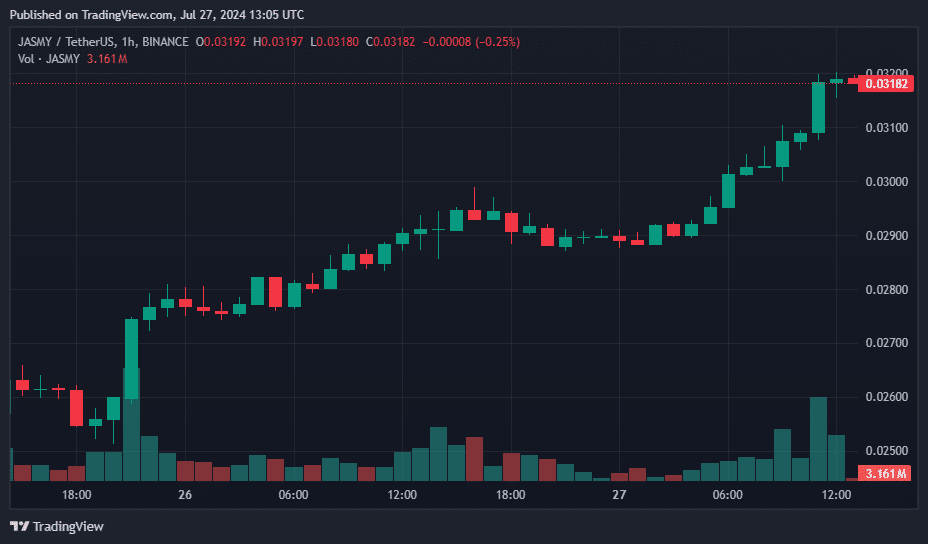
JASMY Hourly Price Chart, July 26-27 | Source: crypto.news
The asset’s market cap has surpassed the $1.5 billion mark, making it the 60th largest cryptocurrency at the time of reporting. However, the self-proclaimed “Bitcoin of Japan” is still down 99.3% from its all-time high of $4.79 on February 16, 2021.
JASMY is the native token of Jasmy Corporation, a Japanese Internet of Things provider. The platform seeks to merge the decentralization of blockchain technology with IoT, allowing users to convert their digital information into digital assets.
The initiative was launched by Kunitake Ando, former COO of Sony Corporation, along with Kazumasa Sato, former CEO of Sony Style.com Japan Inc., Hiroshi Harada, executive financial analyst at KPMG, and other senior executives from Japan.
Kaspa
Kaspa (KAS) saw a 100% increase in trading volume and an 8% increase in price over the past 24 hours, trading at $0.19 at the time of publication.
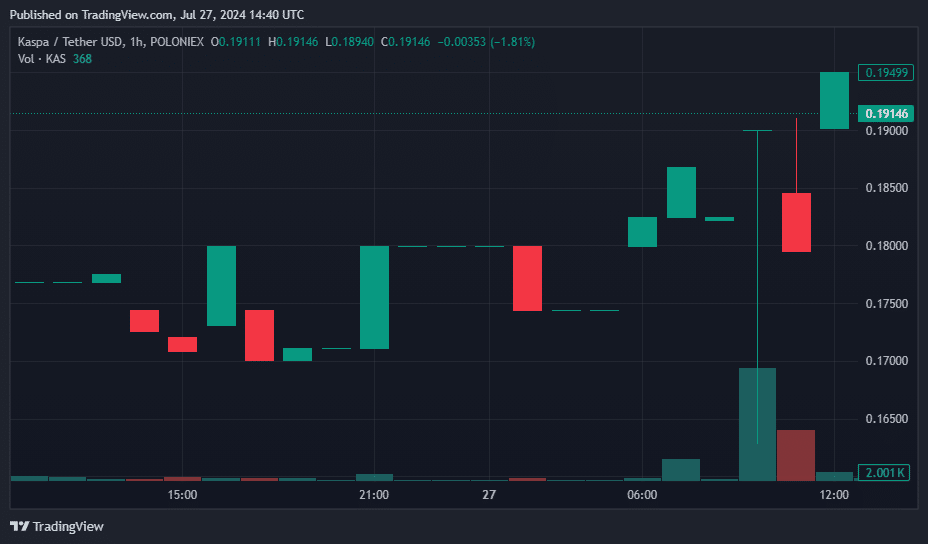
KAS Hourly Price Chart, July 26-27 | Source: crypto.news
According to data from CoinGecko, Kaspa now ranks 27th in the global cryptocurrency list, with a circulating supply of approximately 24.29 billion KAS tokens and a market capitalization of $4.59 billion.
Kaspa is a cryptocurrency designed to deliver a high-performance, scalable, and secure blockchain platform. Its unique Layer-1 protocol includes the GhostDAG protocol, a proof-of-work (PoW) consensus mechanism that enables faster block times and higher transaction throughput compared to standard blockchains.
Unlike Bitcoin, GhostDAG allows multiple blocks to be created simultaneously, speeding up transactions and increasing block rewards for miners.
Bonk
Bonk (BONK) is the only one coin meme which made it to this list of biggest gainers and jumped 8.6% in the last 24 hours. Trading at $0.000030, the Solana-based meme coin’s market cap has surpassed $2.1 billion, surpassing Floki (FLOKI), another competing dog-themed coin with a market cap of $1.78 billion.
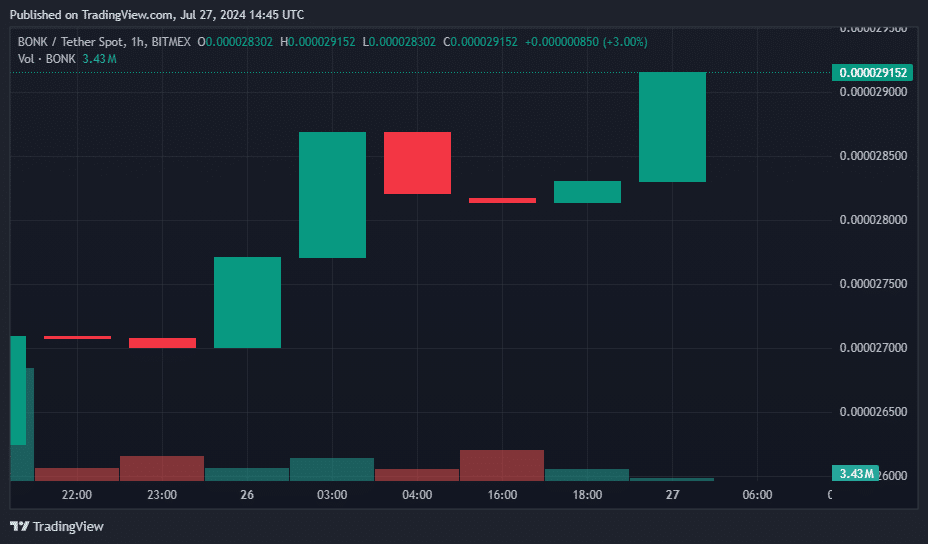
BONK Hourly Price Chart, July 26-27 | Source: crypto.news
BONK’s daily trading volume hovered around $285 million. However, BONK is still down 33.5% from its all-time high of $0.000045, reached on March 4.
Bonk, a meme coin that rose to prominence in 2023, has contributed significantly to Solana’s value increase amid the meme coin frenzy.
Bonk started out as a simple dog-themed coin. It has since expanded its features to include integration with decentralized finance. The project also partners with cross-chain communication protocols, NFT marketplaces, and various other cryptocurrency ecosystems.
BONK trading pairs are now listed on major exchanges including Binance, Coinbase, OKX, and Bitstamp.
The big losers
Bittensor
Bittensor (TAO) was the biggest loser among the 100 largest crypto assets, according to data from CoinGecko.
At the time of writing, TAO, the native token of decentralized AI project Bittensor, was down 5%, trading around $344. The crypto asset had a daily trading volume of $59 million and a market cap of $2.43 billion.

TAO 24 Hour Price Chart | Source: CoinGecko
Bittensor, created in 2019 by AI researchers Ala Shaabana and Jacob Steeves, initially operated as a parachain on Polkadot before transitioning to its own layer-1 blockchain in March 2023.
Mantra
Mantra (OM) fell 6%, trading at $1.13 at press time. The digital currency’s market cap fell to $938 million. Additionally, the 82nd largest crypto asset has a daily trading volume of $26 million.
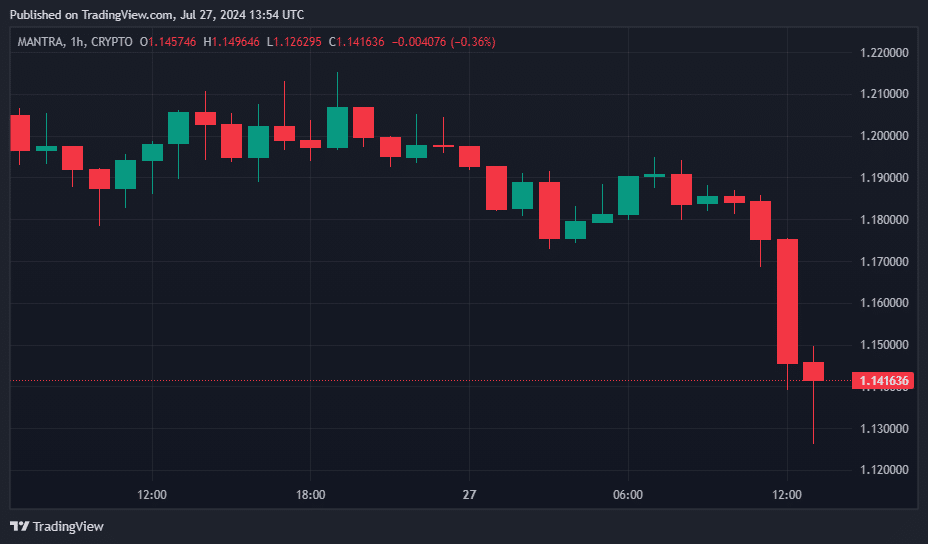
OM Price Hourly Chart, July 26-27 | Source: crypto.news
Mantra is a modular blockchain network comprising two chains, Manta Pacific and Manta Atlantic, specialized in zero-knowledge applications.
Coat
Coat (MNT) also saw a 2.4% drop in price, now trading at $0.8413. Currently, Mantle has a market cap of around $2.75 billion, which ranks 36th in the global cryptocurrency rankings by market cap, according to price data from crypto.news.
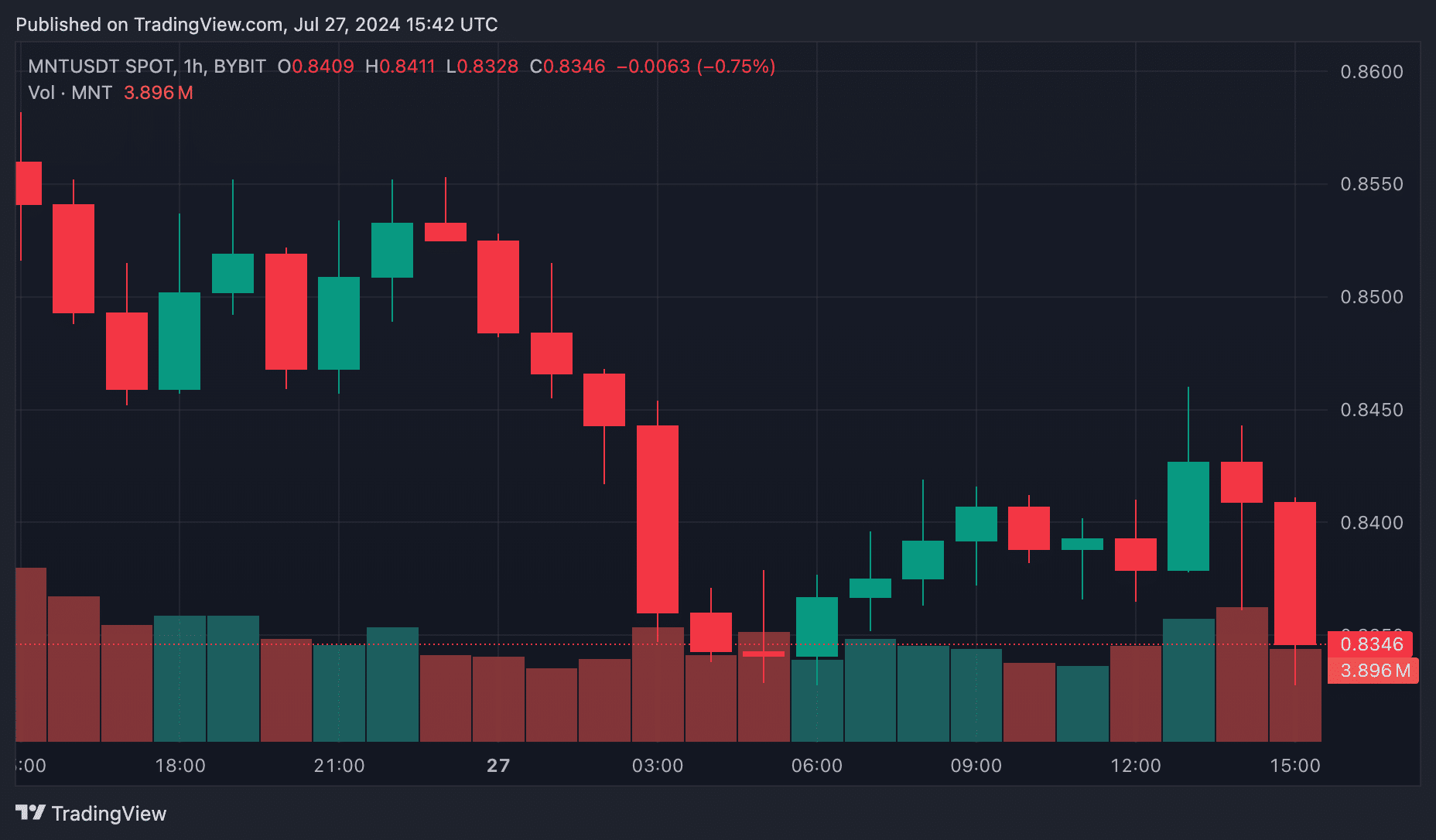
MNT Hourly Price Chart, July 26-27 | Source: crypto.news
Over the past 24 hours, MNT trading volume also fell by 6%, reaching $240 million.
Mantle, formerly known as BitDAO, is an investment DAO closely associated with Bybit. The MNT token is essential for governance, paying gas fees on the Mantle network, and staking on various platforms.
Built on the Ethereum network, Mantle provides a platform for decentralized application developers to launch their projects. It has become particularly popular for GameFi applications, leading to the formation of an internal Web3 gaming team.
Markets
Bitcoin Price Drops to $67,000 Despite Trump’s Pro-Crypto Comments, Further Correction Ahead?

Pioneer cryptocurrency Bitcoin has registered a 1.13% decline in the past 24 hours to trade at $67,400. Despite a strong pro-crypto stance from US presidential candidate Donald Trump at the Bitcoin 2024 conference, this massive selloff has raised concerns in the market about the asset’s sustainability at a higher price. However, given the recent three-week rally, a slight pullback this weekend is justifiable and necessary to regain the depleted bullish momentum.
Bitcoin Price Flag Formation Hints at Opportunity to Break Beyond $80,000
The medium-term trend Bitcoin Price remains a sideways trend amidst the formation of a bullish flag pattern. This chart pattern is defined by two descending lines that are currently shaping the price trajectory by providing dynamic resistance and support.
On July 5, BTC saw a bullish reversal from the flag pattern at $53,485, increasing its asset by 29.75% to a high of $69,400. This recent spike followed the market’s positive sentiment towards the Donald Trump speech at the Bitcoin 2024 conference in Nashville on Saturday afternoon.
Bitcoin Price | Tradingview
In his speech, Trump outlined several pro-crypto initiatives: he promised to replace SEC Chairman Gary Gensler on his first day in office, to establish a Strategic National Reserve of Bitcoin if elected, to ensure that the U.S. government holds all of its assets. Bitcoin assets and block any attempt to create a central bank digital currency (CBDC) during his presidency.
He also claimed that under his leadership, Bitcoin and cryptocurrencies will skyrocket like never before.
Despite Donald Trump’s optimistic promises, the BTC price failed to reach $70,000 and is currently trading at $67,400. As a result, Bitcoin’s market cap has dipped slightly to hover at $1.335 trillion.
However, this pullback is justified, as Bitcoin price has recently seen significant growth over the past three weeks, which has significantly improved market sentiment. Thus, price action over the weekend could replenish the depleted bullish momentum, potentially strengthening an attempt to break out from the flag pattern at $70,130.
A successful breakout will signal the continuation of the uptrend and extend the Bitcoin price forecast target at $78,000, followed by $84,000.
On the other hand, if the supply pressure on the upper trendline persists, the asset price could trigger further corrections for a few weeks or months.
Technical indicator:
- Pivot levels: The traditional pivot indicator suggests that the price pullback could see immediate support at $64,400, followed by a correction floor at $56,700.
- Moving average convergence-divergence: A bullish crossover state between the MACD (blue) and the signal (orange) ensure that the recovery dynamics are intact.
Related Articles
Frequently Asked Questions
A CBDC is a digital form of fiat currency issued and regulated by a country’s central bank. It aims to provide a digital alternative to traditional banknotes.
The proposal for a strategic national Bitcoin reserve is a major confirmation of Bitcoin’s legitimacy and potential as a reserve asset. Such a move could position Bitcoin in a similar way to gold, potentially stabilizing its price and encouraging other countries to adopt similar strategies.
Conferences like Bitcoin 2024 serve as essential platforms for networking, knowledge sharing, and showcasing new technologies within the cryptocurrency industry.
Markets
Swiss crypto bank Sygnum reports profitability after surge in first-half trading volumes – DL News

- Sygnum says it has reached profitability after increasing transaction volumes.
- The Swiss crypto bank does not disclose specific profit figures.
Sygnum, a Swiss global crypto banking group with approximately $4.5 billion in client assets, announced that it has achieved profitability after a strong first half, with key metrics showing year-to-date growth.
The company said in a Press release Compared to the same period last year, cryptocurrency spot trading volumes doubled, cryptocurrency derivatives trading increased by 500%, and lending volumes increased by 360%. The exact figures for the first half of the year were not disclosed.
Sygnum said its staking service has also grown, with the percentage of Ethereum staked by customers increasing to 42%. For institutional clients, staking Ethereum has a benefit that goes beyond the limitations of the ETF framework, which excludes staking returns, Sygnum noted.
“The approval and launch of Bitcoin and Ethereum ETFs was a turning point for the crypto industry this year, leading to a major increase in demand for trusted, regulated exposure to digital assets,” said Martin Burgherr, Chief Client Officer of Sygnum.
He added: “This is also reflected in Sygnum’s own growth, with our core business segments recording significant year-to-date growth in the first half of the year.”
Sygnum, which has also been licensed in Luxembourg since 2022, plans to expand into European and Asian markets, the statement said.
Markets
Former White House official Anthony Scaramucci says cryptocurrency bull market could be sparked by regulatory clarity

Anthony Scaramucci, founder of Skybridge Capital, says the next cryptocurrency bull market could be sparked by a new wave of clear cryptocurrency regulations.
In a new interview On CNBC’s Squawk Box, the former White House communications director said he and two other prominent industry figures traveled to Washington, D.C. to speak to officials about the dangers of Sen. Elizabeth Warren and U.S. Securities and Exchange Commission (SEC) Chairman Gary Gensler’s hardline approach to cryptocurrency regulation.
“Mark Cuban, myself, and Michael Novogratz were in Washington a few weeks ago to speak with White House officials and explain the dangers of Gary Gensler and Elizabeth Warren’s anti-crypto approach. I hope that message gets through…
“Overall, if we can get regulatory policy around Bitcoin and crypto assets in sync, we will have a bull market next year for these assets.”
Scaramucci then compares crypto assets to ride-hailing company Uber, saying regulators were initially wary of the service but eventually decided to adopt clear guidelines due to public demand.
“Remember Uber: Nobody wanted Uber. A lot of regulators didn’t want it. Mayors and deputy mayors didn’t want it, but citizens wanted Uber and eventually accepted the idea of regulating it fairly. I think we’re there now.”
The CEO also says young Democratic voters believe their leaders are making the wrong choices when it comes to digital assets.
“I think President Trump’s move toward Bitcoin and crypto assets has shaken Democrats to their core, and I think very smart, younger Democrats are recognizing that they are completely off base with their positions, completely off base with these SEC lawsuits and regulation by law enforcement, and now they need to get back to the center.”
Don’t miss a thing – Subscribe to receive email alerts directly to your inbox
Check Price action
follow us on X, Facebook And Telegram
Surf The Daily Hodl Mix
 
Disclaimer: Opinions expressed on The Daily Hodl are not investment advice. Investors should do their own due diligence before making any high-risk investments in Bitcoin, cryptocurrencies or digital assets. Please be advised that your transfers and trades are at your own risk, and any losses you may incur are your responsibility. The Daily Hodl does not recommend the buying or selling of any cryptocurrencies or digital assets, nor is The Daily Hodl an investment advisor. Please note that The Daily Hodl participates in affiliate marketing.
Image generated: Midjourney
-

 Videos4 weeks ago
Videos4 weeks agoAbsolutely massive: the next higher Bitcoin leg will shatter all expectations – Tom Lee
-

 News12 months ago
News12 months agoVolta Finance Limited – Director/PDMR Shareholding
-

 News12 months ago
News12 months agoModiv Industrial to release Q2 2024 financial results on August 6
-

 News12 months ago
News12 months agoApple to report third-quarter earnings as Wall Street eyes China sales
-

 News12 months ago
News12 months agoNumber of Americans filing for unemployment benefits hits highest level in a year
-

 News1 year ago
News1 year agoInventiva reports 2024 First Quarter Financial Information¹ and provides a corporate update
-

 News1 year ago
News1 year agoLeeds hospitals trust says finances are “critical” amid £110m deficit
-

 Markets1 year ago
Markets1 year agoWhale Investments in Bitcoin Hit $100 Billion in 2024, Fueling Insane Investor Optimism ⋆ ZyCrypto
-

 DeFi1 year ago
DeFi1 year ago🏴☠️ Pump.Fun operated by Insider Exploit
-

 Videos1 year ago
Videos1 year ago$1,000,000 worth of BTC in 2025! Get ready for an UNPRECEDENTED PRICE EXPLOSION – Jack Mallers
-

 Videos1 year ago
Videos1 year agoABSOLUTELY HUGE: Bitcoin is poised for unabated exponential growth – Mark Yusko and Willy Woo
-

 Tech1 year ago
Tech1 year agoBlockDAG ⭐⭐⭐⭐⭐ Review: Is It the Next Big Thing in Cryptocurrency? 5 questions answered





